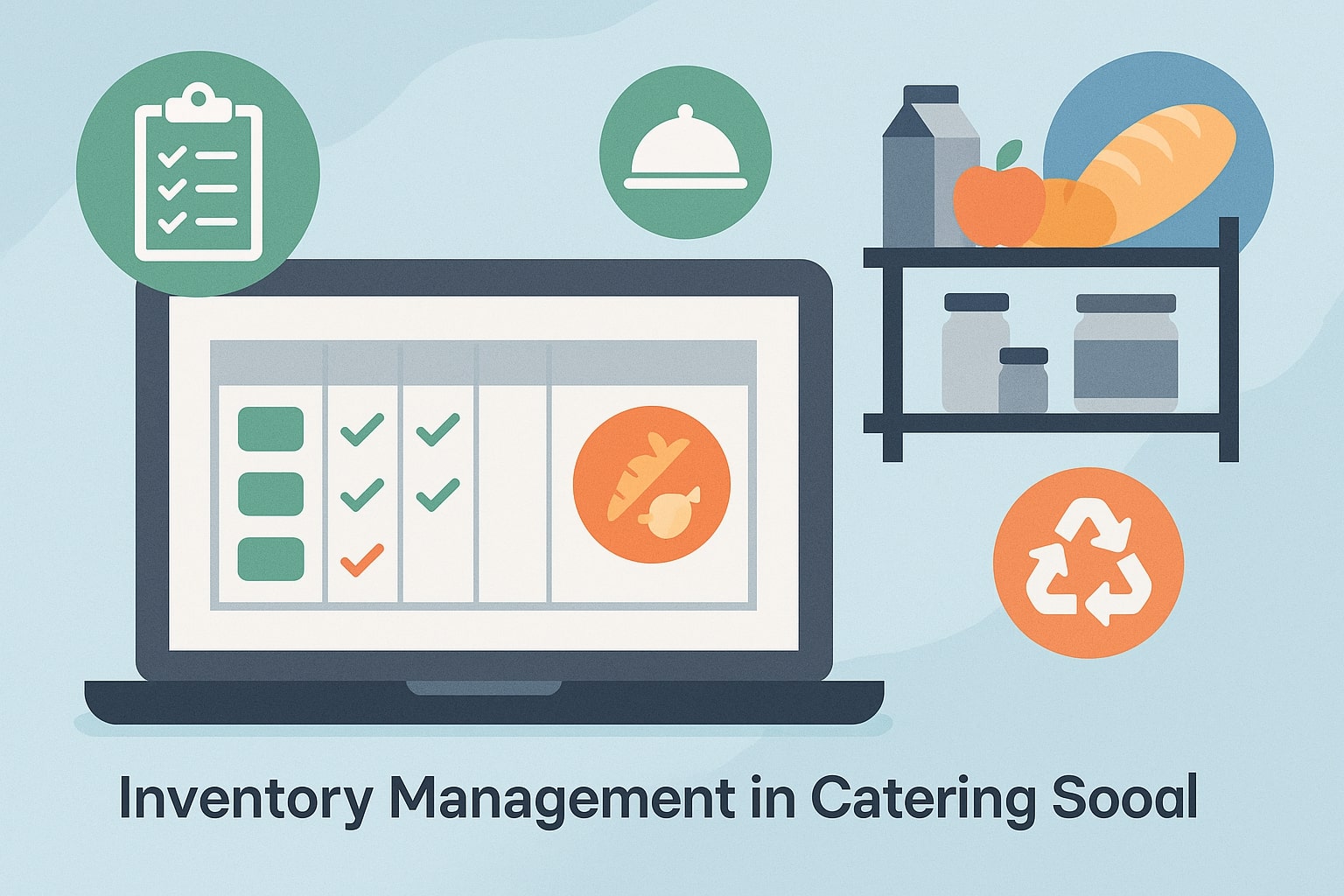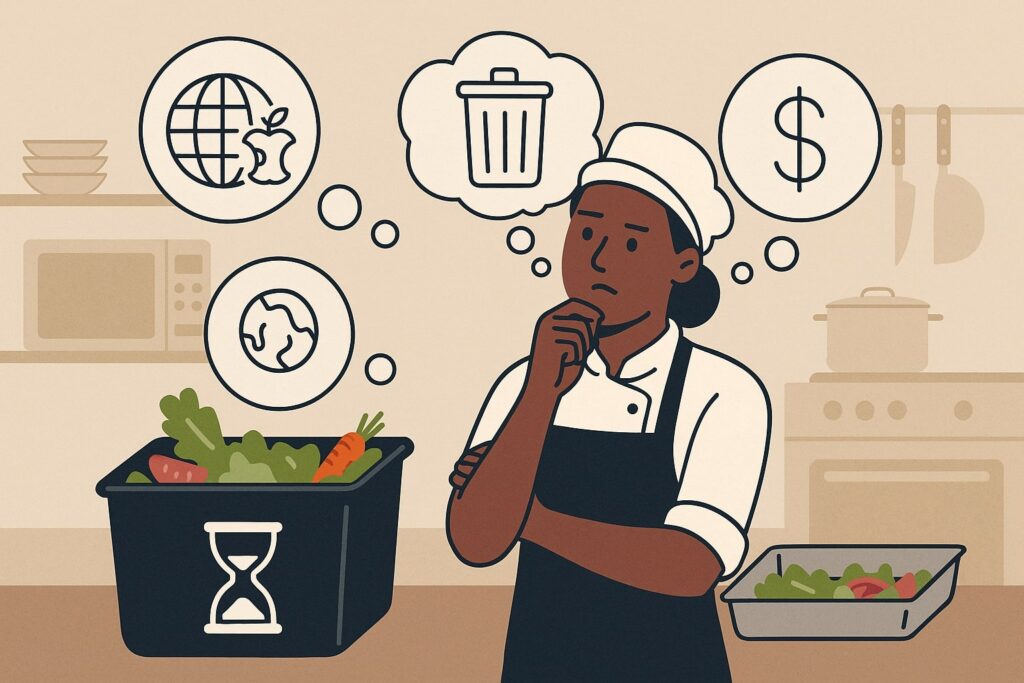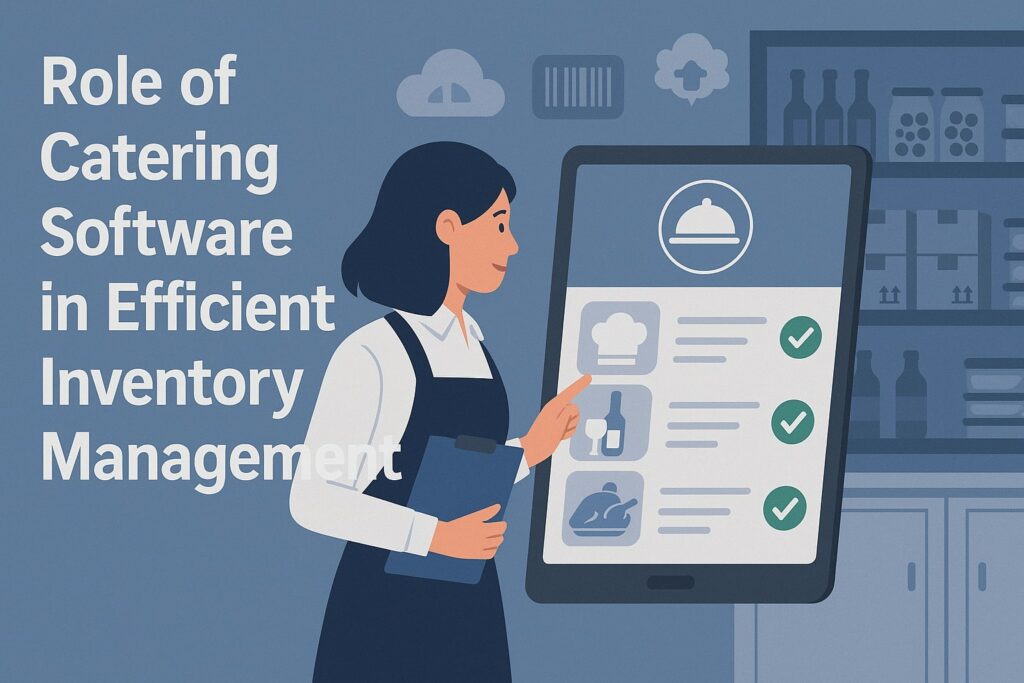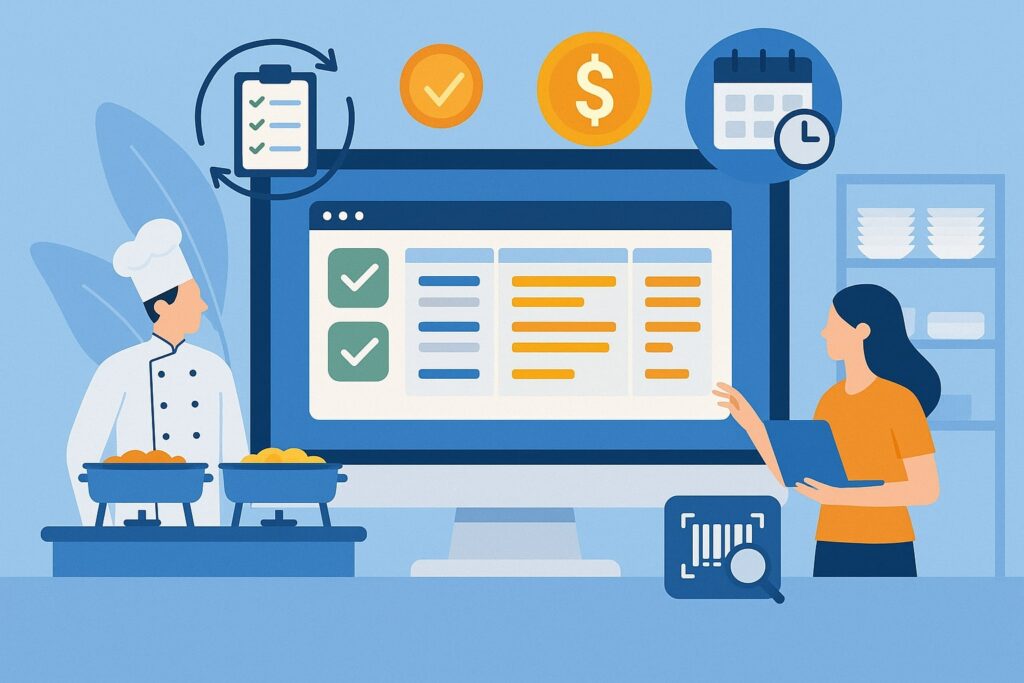
By cloudcateringmanager October 9, 2025
Effective inventory management is crucial in the catering industry, where food costs and waste can significantly impact the bottom line. In the United States, businesses discard nearly 60 million tons of food each year.
Restaurants alone incur roughly $162 billion in waste-related costs annually. These figures highlight the scale of the problem and the opportunity for caterers to save money while promoting sustainability.
Consumers are increasingly aware of food waste: an overwhelming 91% of customers say they prefer buying from businesses that actively reduce food waste. In fact, industry data suggests that every $1 saved by cutting food waste can generate up to $14 in additional revenue.
Catering businesses that optimize their inventory not only support environmental goals but also gain a competitive advantage and happier customers. By keeping costs down and using supplies efficiently, such software helps ensure ingredients stay fresh, supplies meet demand, and waste is minimized.
Understanding Food Waste Challenges in Catering

Catering services face unique food waste challenges compared to regular restaurants. Many menu items involve perishable ingredients like fresh produce, dairy, meat, and seafood, all of which require strict tracking to avoid spoilage.
Demand for these items can fluctuate dramatically depending on event size, season, or menu changes, making accurate forecasting essential. For example, catering an outdoor summer wedding may need far more ice and beverages than an indoor meeting.
Supply chain disruptions can also hit catering hard; delays from suppliers or sudden shortages mean caterers must plan carefully to prevent unexpected stockouts or last-minute rush orders.
Furthermore, frequent menu updates or special dietary requests can complicate inventory planning. If a kitchen switches from chicken to tofu-based dishes, managers must rapidly adjust orders of meat and soy products.
Waste often happens at three points: when ordering and receiving inventory, during food prep, and on the customer’s plate. Improper inventory tracking is a top driver of waste: over-ordering ingredients or missing spoilage dates leads to unnecessary scraps.
In the kitchen, over-preparation can mean cooked food goes unsold and is discarded. Customers also contribute to waste if portion sizes are too large and plates are left half-eaten. All of these factors make it essential for caterers to use precise inventory control and efficient kitchen processes.
By understanding these challenges, businesses can target improvements that reduce waste and save costs (for example, by adjusting portion sizes or retraining staff on storage practices).
Role of Catering Software in Efficient Inventory Management

Modern catering software transforms inventory from a manual chore into a strategic asset. Specialized platforms automate stock tracking and ordering, ensuring staff know exactly what supplies are on hand at all times.
For instance, many systems link directly with the point-of-sale (POS) system and supplier databases. When a menu item is sold, its ingredient usage is automatically deducted from inventory.
Likewise, if an ingredient’s stock falls below a set threshold, the software can trigger a purchase order to replenish it. This real-time synchronization prevents human error in entry and keeps the kitchen running smoothly during busy events.
Catering software also leverages data to minimize waste. Advanced systems incorporate demand forecasting and analytics, learning from past sales, special events, weather, and holidays to predict how much of each ingredient will be needed.
For example, if a restaurant usually sells extra satay skewers during a local festival, the software will suggest stocking slightly more meat for that event.
By aligning orders with actual demand, caterers avoid over-ordering perishable goods that would otherwise spoil. AI-driven features are increasingly common: modern inventory tools can analyze trends and weather patterns to fine-tune forecasts.
Another benefit of catering inventory software is visibility across multiple locations. For catering companies that operate commissary kitchens or multiple venues, a centralized cloud-based system makes it easy to monitor stock everywhere.
Managers can transfer ingredients between locations when needed, rather than ordering new stock unnecessarily. They can also detect unusual patterns: if a central warehouse shows 10 kg of chicken but only 6 kg remain according to the system, the software flags the discrepancy—an indication of possible spoilage, waste, or theft.
This level of transparency means mistakes are caught quickly. Overall, by automating routine tasks and providing data-driven insights, catering software streamlines operations and directly helps reduce food waste. Nearly half of restaurants already report using inventory software to cut waste, and the trend is growing in catering as businesses recognize the cost savings.
Key Features of Catering Inventory Management Software

Catering inventory solutions typically include a suite of features designed to keep stock in check and waste to a minimum:
- Real-Time Inventory Tracking & POS Integration: Modern systems update inventory continuously. Each sale or deduction is logged immediately, so managers always see current stock levels without waiting for end-of-day counts.
Integration with the POS means ingredient usage is automated: when 20 lunches are sold, the system subtracts the corresponding amounts of rice, meat, vegetables, etc.
This automated flow ensures even large orders don’t result in data discrepancies. If a key ingredient nears depletion, alerts notify purchasing managers to reorder in time. - Automated Ordering & Par-Level Alerts: Many platforms allow users to set par levels (minimum stock thresholds). Once supplies run low, the software can automatically generate purchase orders or alert staff to reorder.
This prevents both overstock and understock. With automated EDI (electronic data interchange) connections, some tools directly send orders to preferred suppliers at the click of a button.
By eliminating manual order tracking, kitchens avoid receiving more of an ingredient than needed (a common source of waste). - Demand Forecasting & Data Analytics: Advanced analytics examine historical sales, seasonal patterns, special events, and even external factors like weather to predict future ingredient needs.
Machine learning models can spot that, for example, catering orders for soup increase during colder months. With accurate forecasts, kitchens can cut back on perishable stock when demand is low.
The software often provides dashboards and reports on usage trends, waste hotspots, and cost of goods sold (COGS). Restaurant365 and Crunchtime, for example, offer forecasting tools that suggest how much to order based on predicted sales.
These insights mean chefs and managers make data-driven decisions, reducing guesswork that can lead to excess inventory and waste. - Recipe and Production Management: Many systems allow caterers to build recipes and batch-production worksheets into the software. By linking each dish to its ingredient breakdown, the software knows exactly how much of each item is consumed per event.
Yellow Dog, for instance, lets users scan barcodes and print detailed cost labels, tracking ingredients from receipt to plate. When preparing for a big event, a production sheet can be generated so the system deducts inventory as large batches are cooked.
This tight control ensures no ingredient is overlooked or forgotten in prep, and leftover quantities are minimized. - Cloud-Based and Mobile Access: Leading catering inventory software is cloud-based, meaning all data is stored online and accessible from anywhere. Owners and managers can check stock levels on a laptop, tablet, or even a smartphone, whether they are at the office or off-site.
Mobile apps often let staff do on-the-fly counts or adjustments on the kitchen floor. For example, a chef can use an app to scan a barcode or take a photo of stock, instantly updating the cloud database.
This mobility is critical in catering, where managers may be out at event venues rather than in a central office. Being able to access reports and receive low-stock alerts remotely means reactive last-minute runs to the supplier are greatly reduced. - Multi-Location & Multi-Event Support: Catering companies frequently juggle inventory across different venues or events. The best systems handle multiple “accounts” or locations under one dashboard.
This makes transferring items (e.g. sending five cases of cups from HQ to an off-site wedding location) seamless. It also allows consolidated reporting: a multi-outlet restaurant chain or caterer can see which location used up ingredients fastest.
Such visibility prevents redundant ordering. If one location has surplus salad mix, the software can facilitate an internal transfer rather than throwing it out.
Each of these features contributes to waste reduction. Real-time tracking ensures no items fall through the cracks, automated ordering prevents over-purchasing, and analytics-driven forecasting helps match supply with demand.
Combined with user-friendly mobile apps and cloud connectivity, these tools make it easy for every team member to stay informed. In practice, caterers have found that using such software reduces food costs and waste simultaneously.
Real-Time Tracking & POS Integration
Real-time inventory tracking is a cornerstone of effective management. When inventory data flows continuously from the kitchen to the system, managers no longer rely on error-prone manual counts.
Integrating the software with the POS (point of sale) or ticketing system means each sale or event order automatically deducts the exact ingredients used. For instance, if 10 beef stew meals are sold, the system might deduct 20 lbs of beef and 30 lbs of vegetables in real time.
This integration eliminates guesswork and ensures that inventory levels on the dashboard always reflect reality, day or night. In busy catering operations, this prevents double-counting or missed counts at the end of shifts.
With such visibility, staff can immediately see if a stock discrepancy arises and investigate, rather than discovering after-the-fact that a key ingredient was exhausted.
Automated Ordering & Notifications
Catering software often includes automated replenishment workflows. Users set reorder points for each ingredient (e.g. 10 cases of water bottles), and the system sends an alert or even auto-generates a purchase order when stock dips below that level.
These alerts can be sent by email or push notification to managers. By automating this process, the software helps avoid both waste and stockouts.
If staff fail to notice that a delivery of salsa was missing in some cases, the system flag ensures it doesn’t go unnoticed — preventing the kitchen from running out or ordering more than needed later on.
According to Starkode’s guidelines, leveraging specialized software for reorders and forecasts is a best practice for reducing waste.
Forecasting & Analytics
Demand forecasting is one of the most powerful features. AI and machine learning examine historical sales data and external factors (seasonality, holidays, local events) to predict future ingredient requirements.
This intelligence can adjust orders dynamically. For example, a predictively smart system will know to stock extra ice on hot July weekends or additional dairy goods before school events. Such analytics transform inventory from a reactive task into a proactive strategy.
By using past data, caterers can confidently trim unnecessary purchases. Industry reports note that catering firms are increasingly using these “smart” analytics in 2025 to cut down on over-ordering. A well-implemented forecast means fewer last-minute markdowns or disposals of unsold food, directly tackling waste at its root.
Cloud Access & Mobile Management
Cloud-based catering platforms allow managers to oversee inventory from anywhere. Many systems support mobile apps that let staff scan barcodes or log counts on tablets in the kitchen.
For example, a chef can capture the remaining volume of soup with the phone’s camera and the system will update the database. This flexibility is particularly useful in catering, where managers may split time between the office, warehouse, and live event sites.
Being able to check stock and even issue orders via phone means no “lost data” when teams are in the field. FoodMarketHub highlights that cloud-based systems enable owners to monitor stock even when not physically at the shop. This ensures the inventory is always under control, reducing errors that cause waste.
Emerging Technologies in Inventory Management
Cutting-edge technologies are further enhancing catering inventory solutions:
- Artificial Intelligence (AI) & Machine Learning: AI is increasingly built into inventory platforms. Advanced AI algorithms analyze vast datasets – including past sales, weather forecasts, and event calendars – to generate highly accurate forecasts.
By considering complex patterns (for example, a new vegan menu item’s popularity), AI helps optimize ingredient orders. Computer vision is another emerging AI tool: companies like NomadGo use smartphones or cameras to automatically count items on shelves, eliminating manual stock-taking errors.
AI-driven waste analytics can flag inefficiencies; for example, it may learn that salad ingredients waste spiked during a certain season and suggest menu adjustments. These AI insights equip caterers with “monumental” improvements in efficiency.
In short, AI reduces human error and finds hidden trends that lead to smarter purchasing and less spoilage. - Internet of Things (IoT) Sensors: IoT devices are being deployed to monitor kitchen conditions and waste. For instance, temperature and humidity sensors in refrigerators and storage areas can ensure perishable ingredients stay within safe limits.
If a sensor detects a cooler getting too warm, the system alerts staff to use or move those items before they spoil. Smart waste bins with optical sensors are also used: these devices measure fill levels and can report how much food is being thrown away by day or week.
By quantifying waste streams, IoT provides actionable insights — for example, pinpointing a particular prep station as the source of most bread waste. According to industry experts, tracking bin levels and deploying sensor data on waste is key to cutting collections and preventing overflow.
Together, IoT sensors give a 24/7 view of inventory freshness and usage, turning abstract problems into data the team can manage. - Cloud and Mobile Technology: (Expanding on previous section) Software-as-a-Service (SaaS) delivery models and powerful mobile devices mean inventory data is updated and available instantaneously.
Innovations like edge computing allow even offline kitchens to process inventory counts locally and sync once back online. Augmented Reality (AR) is beginning to be explored: some companies envision kitchen staff using AR glasses to see current inventory counts overlaid on storage shelves.
While still nascent, these technologies point toward a future where tracking inventory is seamless. For now, the combination of AI and IoT in cloud platforms is already a revolutionary step.
It turns inventory management from paper records into an automated, intelligent system. Embracing these technologies helps caterers not just react faster but actually predict problems before they happen, greatly reducing food waste.
By investing in these innovations, catering companies can stay ahead. As one industry report notes, AI tools are already predicting demand and even enabling dynamic pricing based on ingredient costs.
The caterers who leverage these tools today will not only minimize waste but also deliver fresher, higher-quality food to clients.
Popular Catering Inventory Management Tools
A range of software solutions on the market address catering inventory needs. Generally, good systems integrate with POS and accounting tools, alert you to pricing changes, and simplify par-level management.
For example, MarketMan is widely used in the US and often rated best overall for restaurants, featuring barcode scanning, invoicing, and supplier integration.
Toast (with its xtraCHEF module) is popular for operations already using Toast POS; it provides robust inventory tracking and invoice processing. Lightspeed Restaurant also offers built-in inventory that is easy to use for small venues.
For dedicated catering features, Yellow Dog is frequently recommended. It offers detailed recipe costing and multi-site tracking—ideal for businesses with commissary kitchens. Yellow Dog can update ingredient costs in real time and even support bar inventory via its Freepour integration.
According to reviews, Yellow Dog excels at commissary-style operations by automatically depleting a central kitchen’s inventory based on preparations made elsewhere. This helps caterers see exactly how much ingredient volume goes into each event’s production.
Other well-known options include Crunchtime, which is strong on cost control and forecasting, and is used by chains like Chipotle. Crunchtime’s system can suggest orders based on sales forecasts to prevent overstock.
ChefTec and CaterTrax are more specialized for catering menus and event management, often including built-in recipe databases and portioning tools. Smaller businesses might use more general tools like Square for Restaurants or Restaurant365, which include inventory modules suitable for catering with the right setup.
Free and low-cost solutions also exist; for instance, some caterers start with Google Sheets and barcode scanners before scaling up.
In practice, the best choice depends on the business size and specific needs. The unifying theme is that these tools keep costs down and goods fresh by syncing inventory data with all operations.
They may not eliminate every scrap, but they make it far easier to plan, buy, and track ingredients accurately. As one expert notes, inventory software is no longer a luxury – it’s often “the backbone” of a smoothly running catering business.
Best Practices for Reducing Food Waste in Catering
Beyond technology, catering businesses implement operational best practices to fight waste:
- Regular Inventory Audits: Periodic physical counts verify that records match reality. Catching discrepancies early (via cycle counts or full audits) means you can investigate spillage or theft before too much is lost.
Inventory software often schedules and tracks these audits. Finding a mismatch leads to adjustments or staff retraining. Audits also ensure compliance with health codes by avoiding expired items in stock. - First-In, First-Out (FIFO) Rotation: Always use older stock before newer deliveries. Clearly date incoming ingredients and organize shelves so that soon-to-expire items are front and center. Software can enforce FIFO by indicating the oldest lots for use.
Following FIFO reduces spoilage; as industry guides suggest, adhering to expiration dates through proper rotation is a key waste-reduction strategy. - Accurate Forecasting and Purchasing: Use historical data and forecasts to match orders with actual needs. Avoid impulse orders or bulk buys of perishables without demand signals.
For catering, build in flexibility: if a large event is cancelled, having the option to delay or scale back deliveries (e.g. smaller loads or more frequent deliveries) helps. Vendor-managed inventory or just-in-time deliveries can also limit storage time. - Portion Control and Repurposing: Standardize serving sizes. Train staff to use portions from recipes to avoid excess leftovers. When prepping food for events, accurately estimate guest counts and communicate any last-minute changes to the kitchen.
Plan for leftover utilization: if grilled vegetables remain after one event, consider them as ingredients for next-day specials or staff meals before they spoil. - Waste Tracking: Document what does get discarded. Weigh or log scraps and leftover products daily. Only about half of restaurants currently track their waste, but doing so is crucial.
Software can include a “waste log” where staff enter thrown-out quantities by category (vegetables, dairy, etc.). Analyzing these logs over time identifies trends—e.g., too much salad consistently thrown away means portion sizes can be reduced. This continuous feedback loop is essential for improvement. - Staff Training and Engagement: Educate employees on inventory practices and the importance of waste reduction. When staff understand the cost impact of wastage, they are more likely to follow proper prep and storage procedures.
Make waste a visible metric (for example, show charts in the kitchen of waste reduction goals) so everyone feels accountable.
Following these practices, in tandem with the right software, maximizes efficiency. As Starkode advises, combining technology with tactics like regular audits and FIFO rotation yields the best results. In effect, preventing waste before it starts is far easier than dealing with it later.
Frequently Asked Questions
Q: How does catering inventory software specifically help reduce food waste?
A: Catering inventory software streamlines stock control by tracking ingredient usage in real time and predicting needs accurately. It prevents over-ordering through smart reorder alerts and demand forecasts.
When data drives ordering, kitchens buy only what they will use. The system’s FIFO management and expiry tracking ensure older items are used first.
By catching discrepancies early (e.g., identifying missing stock that might spoil) and suggesting appropriate purchase quantities, the software directly minimizes spoilage.
Q: What features should I look for in a catering inventory management system?
A: Key features include real-time tracking, POS/supplier integration, automated ordering, and forecasting. Look for cloud/mobile access so staff can update counts anywhere.
Good systems also let you define recipes and batch production, handle multiple event locations, and report on usage and waste. Automated alerts (e.g., when stock runs low) and data analytics (sales trends, cost reports) are also important. Ensure the software supports FIFO and provides easy audit trails.
Q: Can a small caterer benefit from inventory software, or is it only for large operations?
A: Absolutely. Even small catering businesses gain from basic inventory tools. Cloud-based systems often have tiered pricing, so a small caterer can start with a simple plan. Automation saves small teams time and reduces mistakes.
For example, scanning barcodes on an iPad is faster than manually tallying stock. In fact, 1–2 person caterers using even spreadsheets or free apps often see a quick return by cutting waste and preventing stockouts. As business grows, they can scale up to more advanced features.
Q: Is artificial intelligence (AI) really used in catering inventory management?
A: Yes. Leading catering platforms increasingly incorporate AI. AI algorithms analyze historical sales, weather, and event data to forecast demand. Some solutions use computer vision (via cameras or smartphones) to count inventory automatically.
For example, NomadGo’s AI-powered system can scan shelves to update stock levels instantly. This reduces human error in counts and uses predictive analytics to minimize overstock. AI isn’t just a buzzword; it’s being used now to make ordering smarter and waste tracking more precise.
Q: What kind of return on investment (ROI) can I expect from using inventory management software?
A: The ROI can be substantial. Industry research notes that each $1 saved in food waste can result in up to $14 additional revenue. By reducing spoilage and optimizing orders, even a small reduction in waste can have a big impact on the bottom line.
Additionally, labor savings from faster audits and ordering contribute to ROI. Many users report recouping software costs quickly through lower food costs.
Plus, as consumer demand for sustainability grows, reducing waste can also boost customer loyalty and brand reputation. These combined benefits typically make inventory management software cost-effective for catering businesses.
Conclusion
In the fast-paced catering industry, inventory management software is a game-changer for reducing food waste and cutting costs. By providing accurate, real-time visibility into stock levels and predicting needs, modern systems help caterers avoid over-ordering and spoilage.
Integrations with POS and suppliers automate tedious tasks, while data analytics and AI turn historical sales into actionable forecasts. These tools, when combined with time-tested practices like FIFO and portion control, can transform a complex supply chain into an efficient, waste-conscious operation.
Adopting such technology is not merely about following trends; it’s about profitability and sustainability. Every dollar saved through less waste not only boosts profit margins (industry sources say a $1 reduction can yield up to $14 extra revenue) but also resonates with customers who demand eco-friendly practices.
In the US, where food waste totals are among the world’s highest, the onus is on catering businesses to act. The good news is that the solution landscape is mature: whether a large caterer or a small startup, there are accessible software tools to manage inventory effectively.
By standardizing processes, using specialized software, and embracing innovations like AI and IoT, catering operations can significantly shrink their food waste footprint. Ultimately, this leads to fresher meals, happier clients, and healthier profit margins – a recipe for long-term success.